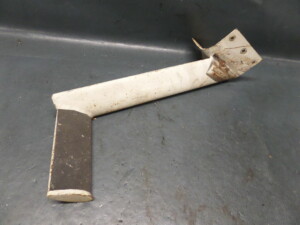The Charity
Aviation
Maritime
GA1338

Initial Report
Whilst disembarking a PA38 post flight I placed my left foot on the step secured to the fuselage below the starboard wing trailing edge. As I released my footing from my right leg – which was on the trailing edge – my left foot slipped from the step and I fell vertically-upright to the apron and landed heavily. I then lost my balance and fell back, impacting my head and lower lumbar region on the apron. I suffered a small cut to the back of my head and bruising as well as back pain. I subsequently learned that other persons have experienced similar falls over the last 3 years due to slippage on the steps of these types: one had severe leg injury and complex surgery; and another had a contusion along his inner quad which could easily have been serious in respect of femoral artery damage. To clarify, the step does have non-slip tape on it (see picture) but, as with all these things, it is below its original efficiency, especially when wet. I would suggest that all operators/owners of these aircraft inspect the condition of the step surfaces and, where necessary, ensure the non-slip surface is intact.
I also think it’s worth highlighting that the PA38 has a shorter wing chord than the PA28 so to close the door and lock the top latch means you have to slide around the door; if a person is used to a PA28 with a longer wing chord (where you can remain comfortably on the inner wing to close the door) it’s an easy ‘oversight’ if you expect footage when stepping back on a PA38. I have communicated my observations to my line manager for awareness and promulgation within the organisation because it is important to highlight the hazards of access/egress if the surface of the steps are not non-slip. They responded positively and requested an SMS report form be completed – the incident will be discussed at the next Safety meeting.
CHIRP Comment
Ensuring that surfaces that we will be stepping on are safe sounds like an obvious precaution but when was the last time that you inspected the friction surfaces of such things as aircraft access steps? Although it’s not exclusively a winter issue, there are many considerations to think about during winter operations and so it’s very easy to overlook something as simple as this. For the sake of a minor outlay in refurbishing such surfaces, a nasty fall or injury could be prevented. Which brings us also to the matter of suitable footwear for flying – those trendy shoes or boots with slick-bottomed soles might not be the best idea after all. Finally, on these types of aircraft it’s best practice to come down from the wing backwards, not forwards, so that you can steady yourself with a hand-hold if you do slip; and also brief passengers if you have any because they will probably not be aware of the risks of slipping on such steps etc.
Key Issues relating to this report
Dirty Dozen Human Factors
The following ‘Dirty Dozen’ Human Factors elements were a key part of the CHIRP discussions about this report and are intended to provide food for thought when considering aspects that might be pertinent in similar circumstances.
Resources – unsuitable slippery step surface
Distraction – focusing on door closure to the detriment of an all-round appreciation of risks
Awareness – did not assimilate that the step surface was worn/slippery
This data type is not supported! Please contact the author for help.